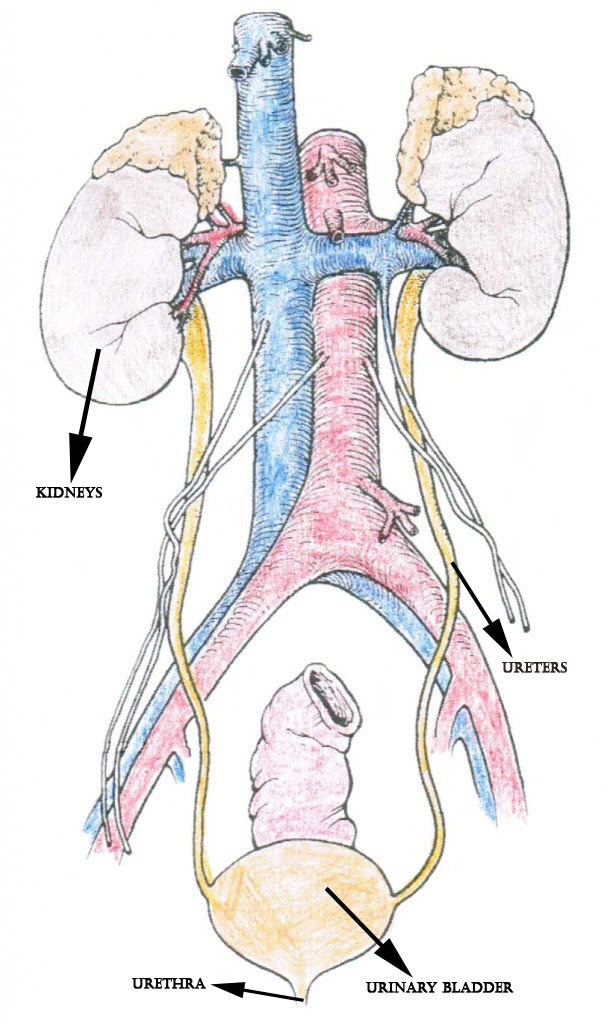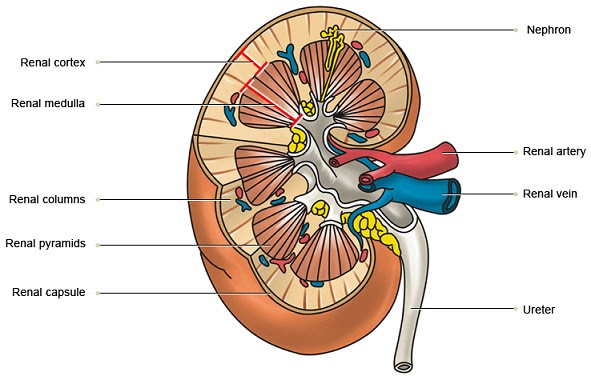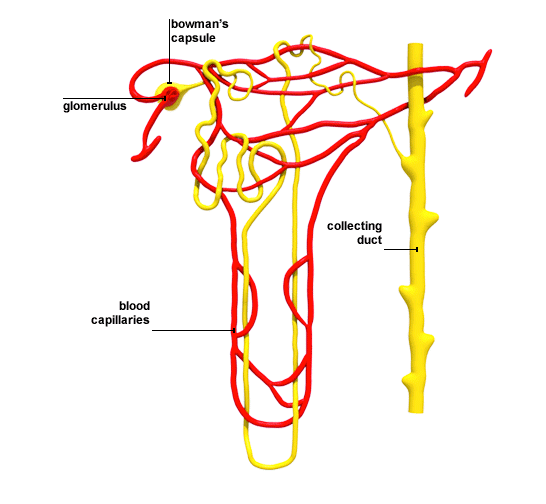
-
INTRODUCTION TO THE UNIRARY SYSTEM
The urinary system consists of all the organs involved in the formation and release of urine. It includes the kidneys, ureters, bladder and urethra.
THE RENEL SYSTEM

Kidneys – collect the body’s waste products and produce urine
Ureters – Muscular tubes that transport urine from each kidney to the bladder.
Urinary Bladder – A sac that collects and holds urine that comes from the ureters.
Urethra – a narrow passageway where urine passes from the bladder to the outside of the body, called urination.
ANATOMY OF KIDNEY

The kidneys are bean shaped pair of organs located in the back of the abdomen. Each kidney is about 4 or 5 inches long -- about the size of a fist.
The blood enters the kidneys via the Renal Artery and leaves via the Renal Vein. Inside each kidney, blood is channeled into a million tiny filters, called a glomerulus (the plural is glomeruli). Glomeruli are joined to small tubes (tubules) to make nephrons and each nephron is surrounded by a network of capillaries. Each kidney contains around a million units called nephrons, each of which is a microscopic filter for blood. At the end of each nephron is the Glomerulus, contained in a cup-shaped Bowman's Capsule. It is here that urine is formed.
Kidney function is divided into three parts: Filtration, Re-absorption & Secretion. In the course of the day 150 litres (33gallons) of filtrate passes into the nephrons. As the fluid passes along these tubes, small molecules such as fats, sugars, salts, amino-acids pass from the capillary into the tubules. Protein molecules being too large are passed out into the blood. After Filtration the fluids of filtrates, is taken back into the blood stream (reabsorbed) which is 100 times the average daily amount of urine.
During Secretion, hydrogen & Potassium ions are removed from the blood and added to the filtrates to be excreted as urine. Here, it finally goes into the ureter and down into the bladder.
The Kidneys, balance the fluid and chemical levels in the body, retain valuable substances, release Hormones, control Blood Pressure, make red blood cells, and maintain healthy bones and teeth.
It's possible to lose as much as 90% of kidney function without experiencing any symptoms or problems.
NEPHRON STRUCTURE:

THE FUNCTIONAL UNIT OF KIDNEY: NEPHRON
The nephron is the kidney's functional unit that removes waste from the body. Each kidney has more than a million nephrons in the renal cortex, which gives it a granular appearance on sagittal section.
There are 2 types of nephrons. The cortical nephrons, which make up about 85 percent, are found deep in the renal cortex, while the juxtamedullary nephrons, which make up about15 percent of total nephrons, lie close to the medulla.
The nephron consists of a renal corpuscle, a tubule, and a capillary network that originates from the small cortical arteries. Each renal corpuscle is composed of a glomerulus (a network of capillaries) and a Bowman's capsule(the cup-shaped chamber that surrounds it.
The glomerulus connects to a long, convoluted renal tubule which is divided into three functional parts. These consist of the loop of Henle (nephritic loop), the proximal convoluted tubule, and the distal convoluted tubule, which empties into the collecting ducts. These collecting ducts fuse together and enter the papillae of the renal medulla.
Urine passes through the renal medulla as a fluid with high sodium content and leaves through the renal papillae, into the renal calyces, into the renal pelvis, and into the bladder through the ureter.
KIDNEY FUNCTION
The urinary system depends on proper kidney structure and function.Hence, core functions of kidneys are as follows:
Excretes waste:The kidneys get rid of toxins, urea, andexcess salts. Urea is a nitrogen-based waste product of cell metabolism that is produced in the liver and transported by the blood to the kidneys.
Maintains water balance:The kidneys help maintain water and electrolyte balance in the body. They react to changes in the water level, which may increase or decrease throughout the day.
Regulates blood pressure:The kidneys help regulate blood pressure by producing angiotensin, a substance that constricts blood vessels and signals the body to retain waterand sodium when blood pressure is low.
Regulates red blood cells:The kidneys produce erythropoietin, a hormone that stimulates your bone marrow to produce more red blood cells when the body does not get enough oxygen.
Regulates acid levels: Acids are products of metabolism. The kidneys help maintain proper acid-base balance to keep the body healthy.